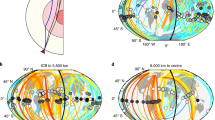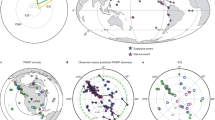Abstract
The transition from the Earth's solid inner core to liquid outer core is the location where the inner core grows1 and from which compositional convection in the outer core originates2,3. Most seismological models of the Earth describe the inner-core boundary as sharp4,5 and simple6,7,8, although experimental data requiring the presence of a thin transition layer at the bottom of the outer core have been reported9. The density jump at the inner-core boundary—an important parameter determining gravitational energy release10 and constraining the compositional difference between the inner and outer core—is also not well known. Estimates of this density jump obtained using free-oscillation eigenfrequencies give low values11,12,13 of 0.25–1.0 g cm-3, whereas a method using the amplitude ratio of core-reflected phases yielded values of 0.6–1.8 g cm-3 (refs 14, 15, 16–17). Here we analyse properties of waves precritically reflected from the Earth's inner core (PKiKP phases) that show significant variability in amplitude, consistent high-frequency content and stable travel times with respect to a standard Earth model4. We infer that the data are best explained by a mosaic structure of the inner core's surface. Such a mosaic may be composed of patches in which the transition from solid inner to liquid outer core includes a thin partially liquid layer interspersed with patches containing a sharp transition.
This is a preview of subscription content, access via your institution
Access options
Subscribe to this journal
Receive 51 print issues and online access
$199.00 per year
only $3.90 per issue
Buy this article
- Purchase on Springer Link
- Instant access to full article PDF
Prices may be subject to local taxes which are calculated during checkout




Similar content being viewed by others
References
Jacobs, J. A. The Earth's inner core. Nature 172, 297–298 (1953)
McFadden, P. L. & Merrill, R. T. Geodynamo source constraints from paleomagnetic data. Phys. Earth Planet. Inter. 43, 22–33 (1986)
Moffatt, H. K. & Loper, D. E. The magnetostrophic rise of a buoyant parcel in the Earth's core. Geophys. J. Int. 117, 394–402 (1994)
Dziewonski, A. M. & Anderson, D. L. Preliminary reference earth model. Phys. Earth Planet. Inter. 25, 297–356 (1981)
Kennett, B. L. N., Engdahl, E. R. & Buland, R. Constraints on seismic velocities in the Earth from traveltimes. Geophys. J. Int. 122, 108–124 (1995)
Engdahl, E. R., Flinn, E. A. & Masse, R. P. Differential PKiKP travel times and the radius of the inner core. Geophys. J.R. Astron. Soc. 39, 457–463 (1974)
Buchbinder, G. G. R., Wright, C. & Poupinet, G. Observations of PKiKP at distances less than 110°. Bull. Seismol. Soc. Am. 63, 1699–1707 (1973)
Cummins, P. & Johnson, L. Synthetic seismograms for an inner core transition of finite thickness. Geophys. J. 94, 21–34 (1988)
Adushkin, V., An, V., Ovtchinnikov, V. & Krasnoshchekov, D. On the density jump at the inner boundary of the Earth's core from observations of PKiKP waves at distances of about 6°. Dokl. Russ. Acad. Sci./Earth Sci. 334, 595–598 (1997)
Gubbins, D., Masters, T. & Jacobs, J. Thermal evolution of the Earth's core. Geophys. J.R. Astron. Soc. 59, 57–99 (1979)
Gilbert, F. & Dziewonski, A. An application of normal mode theory to the retrieval of structural parameters and source mechanisms from seismic spectra. Phil. Trans. R. Soc. Lond. A 278, 187–269 (1975)
Masters, T. G. Observational constraints on the chemical and thermal structure of the Earth's deep interior. Geophys. J.R. Astron. Soc. 57, 507–534 (1979)
Masters, G. & Gubbins, D. On the resolution of density within the Earth. Phys. Earth Planet. Inter. 140, 159–167 (2003)
Bolt, B. A. & Qamar, A. An upper bound to the density jump at the boundary of the Earth's inner core. Nature 228, 148–150 (1970)
Souriau, A. & Souriau, M. Ellipticity and density at the inner core boundary from subcritical PKiKP and PcP data. Geophys. J. Int. 98, 39–54 (1989)
Shearer, P. & Masters, G. The density and shear velocity contrast at the inner core boundary. Geophys. J. Int. 102, 491–498 (1990)
Cao, A. & Romanowicz, B. Constraints on density and shear velocity contrasts at the inner core boundary. Geophys. J. Int. 157, 1146–1151 (2004)
Koper, D. K. & Pyle, M. L. Observations of PKiKP/PcP amplitude ratios and implications for Earth structure at the boundaries of the liquid core. J. Geophys. Res. 109, B03301, doi:10.1029/2003JB002750 (2004)
Koper, D. K., Pyle, M. L. & Franks, J. M. Constraints on aspherical core structure from PKiKP-PcP differential travel times. J. Geophys. Res. 108(B3), 2168, doi:10.1029/2002JB001995 (2003)
Adushkin, V. V. & Ovtchinnikov, V. M. The mosaic in reflections from the Earth's solid core boundary. Dokl. Earth Sci. A 397(6), 883–885 (2004)
Tibuleac, I. M., Nolet, G., Michaelson, C. & Koulakov, I. P wave amplitudes in a 3-D earth. Geophys. J. Int. 155, 1–10 (2003)
Poupinet, G. & Kennett, B. L. N. On the observation of high frequency PKiKP and its coda in Australia. Phys. Earth Planet. Inter. 146, 497–511 (2004)
Buffet, B. A. Geodynamic estimates of the viscosity of the Earth's inner core. Nature 388, 571–573 (1997)
Song, X. D. & Richards, P. G. Seismological evidence for differential rotation of the Earth's inner core. Nature 392, 221–224 (1996)
Song, X. & Helmberger, D. V. A P-wave velocity model of the Earth's core. J. Geophys. Res. 100(B7), 9817–9830, doi:10.1029/94JB03135 (1995)
Schimmel, M. & Paulssen, H. Noise reduction and detection of weak, coherent signals through phase-weighted stacks. Geophys. J. Int. 130, 497–505 (1997)
McFadden, P. L., Drummond, B. J. & Kravis, S. The Nth-root stack: Theory, applications, and examples. Geophysics 51, 1879–1892 (1986)
Efron, B. & Tibshirani, R. Statistical data analysis in the computer age. Science 253, 390–395 (1991)
Richards, P. G. Calculation of body waves, for caustics and tunnelling in core phases. Geophys. J.R. Astron. Soc. 35, 243–264 (1973)
Muller, G. Seismic moment and long-period radiation of underground nuclear explosions. Bull. Seismol. Soc. Am. 63, 847–857 (1973)
Acknowledgements
The research described was made possible in part by contribution from the US Civilian Research & Development Foundation for the Independent States of the Former Soviet Union (CRDF) and individual financial support provided by the Russian Science Support Foundation (RSSF) to D.K.
Author information
Authors and Affiliations
Corresponding author
Ethics declarations
Competing interests
Reprints and permissions information is available at npg.nature.com/reprintsandpermissions. The authors declare no competing financial interests.
Supplementary information
Supplementary Figure S1
Shows map with locations of stations and test sites. (PDF 229 kb)
Supplementary Figure S2
P and PKiKP spectrograms. (PDF 30 kb)
Supplementary Figure S3
PKiKP synthetic seismograms compared with real seismic record. (PDF 7 kb)
Supplementary Table S1
Additional information for Figure 4 of the main text. (PDF 7 kb)
Rights and permissions
About this article
Cite this article
Krasnoshchekov, D., Kaazik, P. & Ovtchinnikov, V. Seismological evidence for mosaic structure of the surface of the Earth's inner core. Nature 435, 483–487 (2005). https://doi.org/10.1038/nature03613
Received:
Accepted:
Issue Date:
DOI: https://doi.org/10.1038/nature03613
This article is cited by
-
Small-scale layered structures at the inner core boundary
Nature Communications (2023)
-
Research on the scatter features of the PKiKP/PcP amplitude ratio and the inner core boundary density contrasts beneath Northeast Asia
Science China Earth Sciences (2021)
-
Non quasi-Hemispherical Seismological Pattern of the Earth’s Uppermost Inner Core
Scientific Reports (2018)
-
Seismological evidence for a localized mushy zone at the Earth’s inner core boundary
Nature Communications (2017)
-
Uppermost Inner Core Heterogeneity from Differential Travel Times of PKIKP vs. PKP-Bdiff and PKP-Cdiff Phases
Pure and Applied Geophysics (2017)
Comments
By submitting a comment you agree to abide by our Terms and Community Guidelines. If you find something abusive or that does not comply with our terms or guidelines please flag it as inappropriate.



